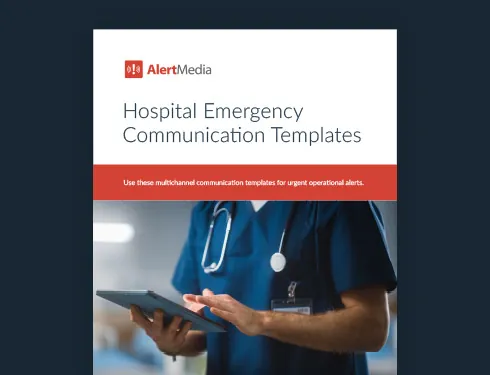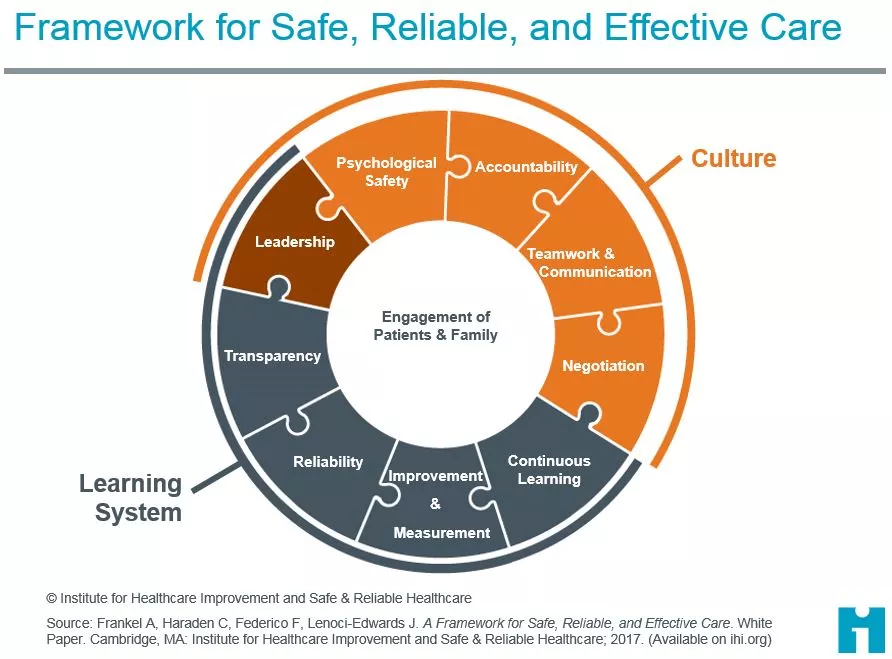
Fostering a Culture of Safety in Healthcare
By cultivating a culture of safety in healthcare organizations, you establish a strong foundation to protect employees and promote patient safety. Here is what you need to consider.

When you enter a healthcare facility, the last thing you want to feel is unsafe. This is true for patients and employees. But healthcare staff faced high rates of injury and illness even before the COVID-19 pandemic, and things have gotten only worse. Workplace injuries and illnesses requiring time off from work increased by as much as 400% from 2019 to 2020.
And safety incidents aren’t restricted to just healthcare workers. The World Health Organization reports that globally, as many as 4 in 10 patients are harmed in primary and outpatient healthcare, with up to 80% of that harm being preventable.
In order to provide a safe place to give and receive care, healthcare organizations need to prioritize building a positive safety culture. When safety is a core value of leaders, frontline workers, and patients, then there will be fewer incidents that could pose undue harm. This article will walk through the unique challenges that the healthcare industry faces when it comes to safety and how to create a solid foundation for their safety culture to protect both employees and patients.
Download Our Hospital Emergency Communication Templates
The Unique Safety Challenges in Healthcare Systems
To build a safety culture, healthcare settings demand special considerations uncommon in other industries.
The most critical consideration is protecting both employee safety and patient safety. Healthcare is centered around patient safety, but protecting the healthcare providers is just as important. Without healthy nurses, doctors, and technicians, there will be no one to care for the patients. This means that the safety culture in a healthcare facility needs to be twofold.
Healthcare leaders use a variety of frameworks to prioritize safety, especially patient safety. This framework was developed by the Institute for Healthcare Improvement. It puts a strong focus on cultural alignment to promote specific areas of growth.

Even with their different approaches, care organizations tend to share the following priorities: transparency, trust, psychological safety, and leadership buy-in. Considering the nuanced nature of these considerations, it’s little surprise that culture is such a huge part of a healthcare safety climate. In order to provide top-tier care, there needs to be an overarching culture that supports your efforts: a culture of safety.
Healthcare providers face particularly dangerous situations, dealing with contagious diseases, hazardous materials and equipment, and a high risk of workplace violence. “There’s not one shift that goes by that a nurse doesn’t get punched, kicked, slapped, hair pulled. That happens every day,” Lona DeNisco, an emergency room nurse in Buffalo, New York, told Time Magazine. Protecting healthcare professionals from violence can be complicated as well since the aggressors are often patients or their family members.

Healthcare workers are also heavily taxed by staffing shortages and overwork. Long hours have been worsened by the demands of COVID patients, ill colleagues, and increasing turnover coinciding with the Great Recession. The strain is leaving many healthcare workers facing mental health issues, with a recent survey showing that “93% of healthcare workers were experiencing stress, 86% reported experiencing anxiety, 77% reported frustration, 76% reported exhaustion and burnout, and 75% said they were overwhelmed.”
Concurrent emergencies can also undermine provider safety and patient care. One major safety concern, like a disease outbreak, can be compounded by other adverse events like a major car crash in the area or a natural disaster. This splits frontline staff focus and heightens stress, which can increase accident rates and medical errors. Since healthcare workers are at the front of every safety incident a community faces, it’s critical that they can work safely and effectively to care for their patients, regardless of additional risks and disruptions.
These challenges make it both more difficult and more important to establish an organizational culture that prioritizes safety above all else. In such a high-risk industry—with such high stakes when it comes to protecting and providing care to patients and community members—building a positive safety culture can bring major benefits to incident rates and security, as well as overall performance.
Benefits of a Culture of Safety in Healthcare
Many safety culture benefits apply to businesses in general, but there are several specific ways in which healthcare organizations benefit.
- Lower rate of malpractice — A positive culture of safety promotes a reliable reporting system and a healthy work environment that can decrease the rate of malpractice and human error. Safety culture also prioritizes safety training programs, which will increase the overall quality of care for patients.
- Longer tenure of employees — Employees across all industries are viewing safety as more important than ever, so when they feel like their employers are prioritizing their safety, they are more likely to stay with the company for longer. And in an industry like healthcare where safety problems are growing and staffing costs are high, an effective safety culture can make a huge difference.
- Reputation boost — High rates of safety incidents can negatively affect an organization’s reputation. But when your culture of safety empowers your employees with safe practices and efficient response times, you’re better equipped to avoid reputation damage. Additionally, when your patient safety culture is proactive and transparent, you will likely see a boost in your reputation.
- Clearer communication — During critical situations, your team must rely on efficient communication. And in the healthcare field, critical situations happen every day. Building a culture of safety means establishing reliable communication channels, like an emergency notification system that allows team members and caregivers to quickly receive and respond to messages from senior leaders or managers about how to respond. It also means establishing a clear incident reporting structure so that all employees are accountable for effective safety procedures.
Framework for Safety Culture Success in Healthcare

You can instill a culture of safety in your organization in eight dedicated steps, outlined in this blog post. But in order to account for the specific needs of the healthcare industry, we have compiled a list of foundational initiatives. You’ll notice that these efforts are interrelated and ongoing, following the evolving needs of the organization, employees, and patients in their care.
Leadership buy-in
Getting support and resources from leadership is especially important in healthcare with high-stakes safety issues in play. Organizational culture comes from the top down. Through transparent, engaging conversations, you can help align owners, board members, and department heads to prioritize safety programs and risk management. After all, your safety initiatives will need sustained funding, as well as examples of leadership commitment. This safety focus will trickle down, and decision-making regarding patient care will become more straightforward and consistent since the default will always be safety first.
Frequent surveys
Surveys can be incredibly helpful in assessing your safety culture. And this goes for more than just the healthcare team. Frequently survey your patients to assess whether they have felt safe and cared for—and to gather any suggestions for future process improvements. For employees, you can make these surveys mandatory, but with patients, you can incentivize respondents for participating.
Trust-building
Trust-building should also be a priority with both team members and patients—as a foundational element of safety culture. Building trust with healthcare staff means transparency and active listening to what they care most about. A systemic culture of patient safety requires high reliability of care. Clinicians should be prepared with good bedside manners, relevant interventions, and general empathy skills when working with patients in order to foster a positive relationship. It’s also important to promote teamwork between departments so that patients are getting consistent messaging across the board.
For healthcare workers, psychological safety means they feel safe bringing their whole selves to work. When you can establish a space of trust where employees’ opinions and cares matter, they will have a better attitude at work since they feel respected and appreciated. And worker health and empowerment can significantly impact patient safety improvement and overall positive experiences. Patients who feel psychologically safe will be more likely to answer questions honestly and more likely to trust the recommendations of their healthcare leaders.
“There is an important relationship between how people feel cognitively, emotionally, and physically and how they can contribute to the organization. Research suggests that when employees feel like they can bring their whole selves to work, they perform better and have better mental health.”
—Dr. Tracy Brower, sociologist & author
Documentation
Documenting everything—from near misses to high-impact emergencies to improvement initiatives—is key to improving your organization’s culture. Just as you document every step in the care process for your patients, it’s important to document all efforts toward safety and security so you have clear records to look back on and assess how your culture change is progressing.
This includes a reliable structure for documenting safety events and error reporting. All of your healthcare workers need to know exactly how event reporting works and to understand that they are supporting a much bigger commitment to quality improvement of patient care. Map out an effective hierarchy for escalation and a straightforward process for initiating escalations. Take the time to train your employees so they understand what is expected of them and why. Having a consistent, transparent system of accountability in place supports not only employee confidence but also patient confidence and trust.
Protecting Those on the Frontline
When your employees are on the frontline of nearly every critical event and work to keep the general public safe, it’s essential to keep them safe as well. Creating a culture of safety in your healthcare systems is one of the best and most reliable ways to protect your employees and ensure your patients get the best quality care possible. And implementing the right technology solutions, such as threat intelligence or a mass notification system, alongside your safety culture can make the whole process smoother and more effective. Learn more about how these solutions can help you by scheduling a demo.

![Risk Management in Healthcare: From Plan to Action [+ Communication Templates]](https://www.alertmedia.com/wp-content/uploads/2023/03/Blog-RiskMgmt-Healthcare-v2a.jpg)


